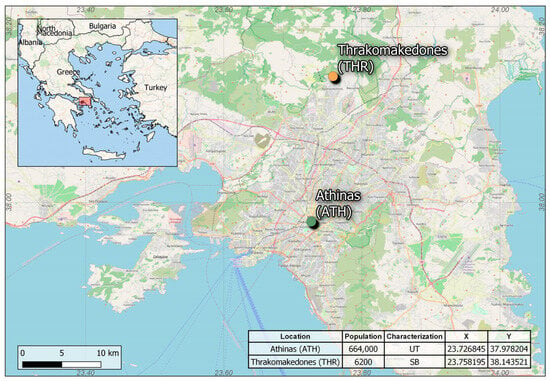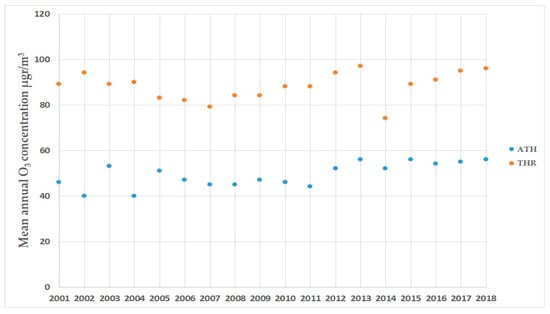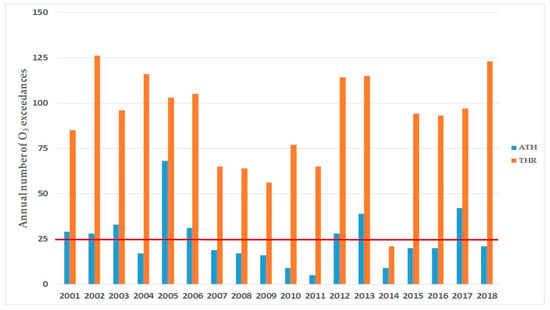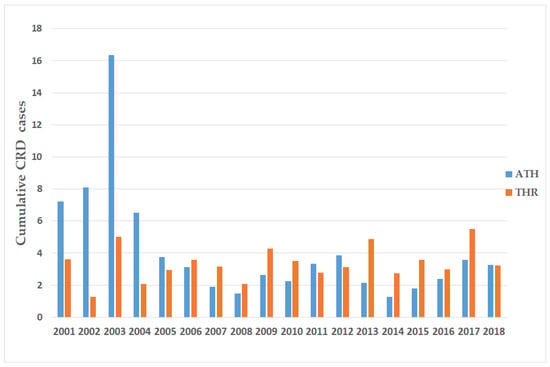Abstract
Ozone is formed in the lower layers of the atmosphere mainly by gases emitted by anthropogenic activities in combination with solar radiation. In the present study, the short-term health impacts of ozone (O3) on people living in the Greater Athens Area in Greece are analyzed for the period 2001–2018 by estimating the cardiorespiratory deaths with the AirQ+ model. Ozone measurements (8-h mean values) for two areas with different characteristics (Thrakomakedones and Athinas) were used provided by the National Air Pollution Monitoring Network. Data processing showed that environmental conditions and geographical characteristics influence O3 variation and the risk of cardiorespiratory deaths. The statistical analysis of O3 measurements revealed that at the southwestern suburb of Thrakomakedones the mean annual concentrations range from 74 to 96 μgr/m3, much higher than in the Athens center (40–56 μgr/m3, station: Athinas). Τhe O3 concentration threshold was exceeded in Thrakomakedones approximately 90 times per year, while in the Athinas monitoring station, it was exceeded only 25 times. According to the AirQ+ software package, the percentage of deaths due to O3 exposure ranges from 6% in Thrakomakedones to 7.5% in the Athinas station.
1. Introduction
Ozone (O3) is a secondary oxidizing compound that is formed in the lower layers of the atmosphere from the reaction of gases mainly from anthropogenic sources and solar radiation [1]. It is harmful to vegetation, materials and human health. In the 25 European Union countries, around 21,000 premature deaths per year occur during and after days with high ozone levels [2].
Ozone pollution episodes last from a few days to two or three weeks and are characterized by exceedances of the limit values proposed by the EU. Meteorological conditions play a catalytic role in the formation, persistence, accumulation and removal of ozone. Solar radiation combined with high temperatures, relative apnea and zero precipitation are conducive to ozone episodes [3]. The higher concentrations are usually measured during the summer months, especially in densely populated urban centers. The acceptable concentrations for the atmosphere to be considered clean are in the range of 20–40 ppb at sea level and 30–70 ppb at higher altitudes. In areas with high ozone concentrations, the range of measurements is from 10 to 350 ppb, with the most common value approaching 150 ppb. Peak ozone values are observed in the late afternoon, decreasing greatly reduced during the night [4].
Scientific interest in high ozone concentrations has grown widely in recent decades because of the negative effects on human health. Studies have provided substantial evidence that both long-term and short-term exposure to ozone are responsible for mortality and cardiopulmonary morbidity [5,6,7]. Moreover, according to the European Environment Agency, in 2016, 645 premature deaths were recorded in Greece due to exposure to high ozone (O3) concentrations, equal to a rate of 0.06 per 10,000 inhabitants, while the average rate in the European Union is 0.027 [8]. Moreover, in the European Environment Agency 2019 report, it is stated that in Greece, 5.4% of the country’s population lives in areas where ozone concentrations are high and usually exceed the ozone limit values [8].
In this study, the short-term health effects of ozone on people living in the Greater Athens Area in Greece for the period 2001–2018 are investigated. Cardiopulmonary deaths due to ozone were estimated using the AirQ+ model, a software package developed by the World Health Organization (WHO) [9]. Ozone measurements (8-hourly mean values) for two areas with different characteristics (Thrakomakedones and Athinas) from monitoring stations, provided by the National Air Pollution Monitoring Network, were used.
2. Materials and Methods
2.1. Study Area Description
The Attica basin is a triangular peninsula located in the southeastern part of Central Greece and bordered by the Aegean Sea. The Greater Athens Area (GAA) is densely populated and includes the urban complex of Athens, i.e., all the municipalities of Athens and Piraeus, and is bounded by the Saronic Gulf and the mountains Parnitha, Ymittos and Penteli. The climate of Attica is typical Mediterranean with mild rainy winters and hot dry summers. In winter, the temperature remains high, with an average January temperature of 9.2 °C, while in summer, the temperature is very high; in addition, heat waves occur two to three times with temperatures above 40 °C [10,11]. There are three main anthropogenic activities that contribute to local air pollution, vehicular traffic, heating of buildings and industry. According to researchers, the huge number of vehicles in circulation, which increases at a rate of 7% per year, is the main cause of problems relating to air pollution, especially during peak hours. Although the use of natural gas for home heating has increased in recent years, heating oil is still used, burdening the atmosphere during the winter [12]. The GAA’s atmosphere is also polluted by natural factors. The beautiful and bright Mediterranean sun unfortunately catalyses’ photochemical pollution and the transported dust from North Africa, enhancing ozone production [13]. The transported desert dust covers the Attica sky during spring and autumn with a total duration of about 30 days per year [13,14]. This phenomenon is associated with the development of childhood asthma and an increase in hospital admissions due to bronchitis [15,16].
As already mentioned, Attica is a region with a complex topography, where there are transitions between land, sea, rural and urban areas, plains and mountains contributing to the development of local wind flows. In particular, two sea breeze cells develop over the Attica peninsula. One sea breeze cell enters from the Saronic Gulf to the south-west, affecting the Athens basin and the Triasio industrial plain. The wind velocities of the cell reach values of about 4 m/s. Similarly, the second cell of the sea breeze develops on the eastern side of the Attica peninsula, over the Mesogean plain, originating from the Gulf of Evia. In the northern part of the Athens basin, a convergence zone is formed between the sea breeze from the Saronic Gulf, the synoptic northern flow and a sea breeze flow from the east of the Attica peninsula [17], thus contributing to the particularly high concentration of O3 on the northern side of Attica, as will be presented in this study.
2.2. Air Pollution Data and Population
In the present study, the temporal variation of O3 concentrations at two stations in the wider Athens area and the effects on the health of residents were examined. For this purpose, daily mean O3 concentrations for the period 2001–2018 were obtained from two air pollution monitoring stations (Thrakomakedones and Athinas), located in the GAA (Figure 1). These stations belong to the air pollution monitoring network of Attica, which is part of the Climate Change and Air Quality Directorate (CAA) and operates within the framework of the supervision of the Greek Ministry of Environment and Energy (MEEE) [10]. Based on their location and their categorization due to air pollution sources, the Athinas station is classified as an urban traffic station (UT), and the Thrakomakedones station is classified as a suburban background station (SB). Furthermore, the population data of the local area of each station are presented, obtained from the Hellenic Statistical Authority (ELSTAT) according to the 2011 population census [18]. Statistical analysis and processing of O3 concentrations were performed in accordance with Directive 2008/50/EC of the European Parliament [19], which sets a maximum 8-h average daily value over a one-year period of 120 µg/m3 that should not be exceeded more than 25 times per year. Also, ELSTAT, upon request, provided the recorded deaths from cardiac and respiratory causes for each region for the years 2001–2018.

Figure 1.
Map with the location of O3 monitoring stations (Background map data from OpenStreetMap).
2.3. AirQ+ Model
Health effects due to short-term O3 exposure were quantified using the AirQ+ model (version 2.1.1) developed by the World Health Organization (WHO) Regional Office for Europe [18]. AirQ+ model requires the following data to assess the public health effects of O3: (1) the total population of the area, (2) the O3 concentration, using the ozone indicator of the Sum of Ozone Means Over 35 ppb (SOMO35), (3) the annual number of deaths for each region from circulatory or cardiorespiratory diseases, and (4) the Relative Risk (RR) coefficient, a statistical parameter used in epidemiological studies. A value of 1.014 (95% CI = 1.005, 1.024) per 10 μgr/m3 was considered for O3 [9,20].
3. Results and Discussion
Figure 2 presents the temporal variation of the average concentration of the pollutant O3 for the period 2001–2018. Overall, at the southwestern suburb of Thrakomakedones, the mean annual concentrations range from 74 to 96 μgr/m3, much higher than in the Athens center (range: 40–56 μgr/m3, station: Athinas).

Figure 2.
Mean annual O3 μgr/m3 concentration at Athinas and Thrakomakedones stations.
As shown in Figure 3, at the Thrakomakedones station, the O3 concentration limit (120 μg/m3) was exceeded many times throughout the period under consideration. Specifically, in 2018 the concentration exceeded 123 times at the Thrakomakedones station, while at the Athinas monitoring station it was exceeded only 21 times. It should be mentioned that the target value should not be exceeded on more than 25 days per year (red line in Figure 3). In general, O3 concentration threshold was exceeded in the Thrakomakedones station about 90 times per year, while in the Athinas monitoring station, it was exceeded only 25 times. This occurs because the sea breeze that blows encloses the O3 at the foothills of Parnitha.

Figure 3.
Number of O3 exceedances per year at Athinas and Thrakomakedones stations.
Figure 4 depicts the cumulative annual number of Chronic Respiratory Disease (CRD) deaths from cardiorespiratory causes in adults per 100,000 population attributable to O3, over the period 2001–2018. While Thrakomakedones is a sparsely populated suburb compared to the center of Athens, which is densely populated, they show similar rates of CRD cases deaths due to O3. As illustrated in Figure 4, mainly after 2005, deaths due to O3 exposure at the Thrakomakedones station are approximately at the same level as those at the Athinas station. Overall, according to the results of the AirQ+, the percentage of deaths due to O3 exposure is about 6% in Thrakomakedones and 7.5% in the center of Athens.

Figure 4.
Annual variation in cumulative CRD cases due to O3 at Athinas and Thrakomakedones stations. Period: 2001–2018.
4. Conclusions
In this study, the short-term adverse health effects due to ozone exposure have been evaluated according to the guidelines of the WHO. The main objective of this study was to estimate lung and cardiocirculatory deaths in adults attributable to O3 exposure in an urban area of Athens (center) and a northern suburb during the years 2001–2018, conducted using the AirQ+ software package. As regards the annual mean variation of O3 and the annual exceedances of the O3 limit at both stations, there is no change indicating a decrease. However, O3 levels at Thrakomakedones (northern GAA) were found to be significantly higher compared to those in the center of Athens. The phenomenon of O3 accumulation in the northern part of the Athens basin is repeated due to the topography of the area and the sea breeze [17,21,22]. These results have accordingly influenced the estimate of the number of deaths from cardiorespiratory causes per 100,000 adults attributable to O3 exposure in the two regions, during the years 2001–2018. In the densely populated urban area of Athinas, according to the AirQ+ software package, the rate of deaths due to O3 exposure is 7.5%, and in the sparsely populated northern suburb of Thrakomakedones, it is 6%. Future research is required to investigate how the magnitude of mortality risk is affected due to seasonal variation O3, being more pronounced in warmer weather conditions favored by the sea breeze.
Author Contributions
K.N. methodology, K.N.; formal analysis, K.N. and K.-M.F.; investigation, K.N., A.A. and K.-M.F.; resources, K.N.; data curation, K.N. and A.A.; writing—original draft preparation, K.N. and K.-M.F.; visualization, K.N. and C.T. supervision, K.N., K.-M.F. and K.M.; All authors have read and agreed to the published version of the manuscript.
Funding
This research received no external funding.
Institutional Review Board Statement
Not applicable.
Informed Consent Statement
Not applicable.
Data Availability Statement
The data presented in this study are available on request from the corresponding author.
Acknowledgments
This publication was fully funded by the University of West Attica.
Conflicts of Interest
The authors declare no conflict of interest.
References
- Wilkinson, S.; Mills, G.; Illidge, R.; Davies, W.J. How Is Ozone Pollution Reducing Our Food Supply? J. Exp. Bot. 2012, 63, 527–536. [Google Scholar] [CrossRef] [PubMed]
- Amann, M. Health Risks of Ozone from Long-Range Transboundary Air Pollution; World Health Organization, Regional Office for Europe: Copenhagen, Denmark, 2008; ISBN 978-92-890-4290-1. [Google Scholar]
- Solomon, S.; Ivy, D.; Gupta, M.; Bandoro, J.; Santer, B.; Fu, Q.; Lin, P.; Garcia, R.R.; Kinnison, D.; Mills, M. Mirrored Changes in Antarctic Ozone and Stratospheric Temperature in the Late 20th versus Early 21st Centuries. J. Geophys. Res. Atmos. 2017, 122, 8940–8950. [Google Scholar] [CrossRef]
- Zhang, J.; Wei, Y.; Fang, Z. Ozone Pollution: A Major Health Hazard Worldwide. Front. Immunol. 2019, 10, 2518. [Google Scholar] [CrossRef] [PubMed]
- Gryparis, A.; Forsberg, B.; Katsouyanni, K.; Analitis, A.; Touloumi, G.; Schwartz, J.; Samoli, E.; Medina, S.; Anderson, H.R.; Niciu, E.M.; et al. Acute Effects of Ozone on Mortality from the “Air Pollution and Health: A European Approach” Project. Am. J. Respir. Crit. Care Med. 2004, 170, 1080–1087. [Google Scholar] [CrossRef] [PubMed]
- Salonen, H.; Salthammer, T.; Morawska, L. Human Exposure to Ozone in School and Office Indoor Environments. Environ. Int. 2018, 119, 503–514. [Google Scholar] [CrossRef] [PubMed]
- Jerrett, M.; Burnett, R.T.; Pope, C.A.; Ito, K.; Thurston, G.; Krewski, D.; Shi, Y.; Calle, E.; Thun, M. Long-Term Ozone Exposure and Mortality. N. Engl. J. Med. 2009, 360, 1085–1095. [Google Scholar] [CrossRef]
- European Environment Agency. Greece—Air Pollution Country Fact Sheet. Available online: https://www.eea.europa.eu/themes/air/country-fact-sheets/2021-country-fact-sheets/greece (accessed on 23 September 2022).
- World Health Organization. WHO Global Air Quality Guidelines: Particulate Matter (PM2.5 and PM10), Ozone, Nitrogen Dioxide, Sulfur Dioxide and Carbon Monoxide; World Health Organization: Geneva, Switzerland, 2021; ISBN 978-92-4-003422-8. [Google Scholar]
- HMEE Hellenic Ministry of Environment and Energy. Available online: https://ypen.gov.gr/ (accessed on 30 April 2021).
- Meteo Weather Forecasts for All of Greece. Available online: http://www.meteo.gr/ (accessed on 26 September 2022).
- Athanasios, V.; Vlachogianni, T.; Loridas, S.; Fiotakis, C. Atmospheric Pollution in Urban Areas of Greece and Economic Crisis. 2015. Available online: https://www.researchgate.net/publication/284415702_.26 (accessed on 23 August 2023).
- Lionello, P. The Climate of the Mediterranean Region; Elsevier: Amsterdam, The Netherlands, 2012; ISBN 978-0-12-416042-2. [Google Scholar]
- Spyropoulos, G.C.; Nastos, P.T.; Moustris, K.P.; Chalvatzis, K.J. Transportation and Air Quality Perspectives and Projections in a Mediterranean Country, the Case of Greece. Land 2022, 11, 152. [Google Scholar] [CrossRef]
- Samoli, E.; Nastos, P.T.; Paliatsos, A.G.; Katsouyanni, K.; Priftis, K.N. Acute Effects of Air Pollution on Pediatric Asthma Exacerbation. Environ. Res. 2011, 111, 418–424. [Google Scholar] [CrossRef] [PubMed]
- Trianti, S.-M.; Samoli, E.; Rodopoulou, S.; Katsouyanni, K.; Papiris, S.A.; Karakatsani, A. Desert Dust Outbreaks and Respiratory Morbidity in Athens, Greece. Environ. Health 2017, 16, 72. [Google Scholar] [CrossRef]
- Mavrakou, T.; Philippopoulos, K.; Deligiorgi, D. The Impact of Sea Breeze under Different Synoptic Patterns on Air Pollution within Athens Basin. Sci. Total Environ. 2012, 433, 31–43. [Google Scholar] [CrossRef]
- HSA Hellenic Statistical Authority. Available online: https://www.statistics.gr/en/home/ (accessed on 20 June 2021).
- EUR-Lex Directive 2008/50/EC of the European Parliament and of the Council of 21 May 2008 on Ambient Air Quality and Cleaner Air for Europe. Available online: http://data.europa.eu/eli/dir/2008/50/oj (accessed on 23 August 2023).
- Héroux, M.-E.; Anderson, H.R.; Atkinson, R.; Brunekreef, B.; Cohen, A.; Forastiere, F.; Hurley, F.; Katsouyanni, K.; Krewski, D.; Krzyzanowski, M.; et al. Quantifying the Health Impacts of Ambient Air Pollutants: Recommendations of a WHO/Europe Project. Int. J. Public Health 2015, 60, 619–627. [Google Scholar] [CrossRef]
- Dandou, A.; Tombrou, M.; Soulakellis, N. The Influence of the City of Athens on the Evolution of the Sea-Breeze Front. Bound.-Layer Meteorol. 2009, 131, 35–51. [Google Scholar] [CrossRef]
- Melas, D.; Kioustioukis, I.; Lazaridis, M. The Impact of Sea Breeze on Air Quality in Athens Area. In Advances in Air Pollution Modeling for Environmental Security; Springer: Berlin/Heidelberg, Germany, 2005; Volume 54, pp. 285–295. ISBN 978-1-4020-3349-0. [Google Scholar]
Disclaimer/Publisher’s Note: The statements, opinions and data contained in all publications are solely those of the individual author(s) and contributor(s) and not of MDPI and/or the editor(s). MDPI and/or the editor(s) disclaim responsibility for any injury to people or property resulting from any ideas, methods, instructions or products referred to in the content. |
© 2023 by the authors. Licensee MDPI, Basel, Switzerland. This article is an open access article distributed under the terms and conditions of the Creative Commons Attribution (CC BY) license (https://creativecommons.org/licenses/by/4.0/).